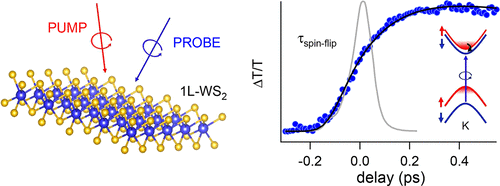当前位置:
X-MOL 学术
›
Nano Lett.
›
论文详情
Our official English website, www.x-mol.net, welcomes your
feedback! (Note: you will need to create a separate account there.)
Intravalley Spin–Flip Relaxation Dynamics in Single-Layer WS2
Nano Letters ( IF 9.6 ) Pub Date : 2018-09-28 00:00:00 , DOI: 10.1021/acs.nanolett.8b02774 Zilong Wang 1 , Alejandro Molina-Sánchez 2 , Patrick Altmann 1 , Davide Sangalli 3 , Domenico De Fazio 4 , Giancarlo Soavi 4 , Ugo Sassi 4 , Federico Bottegoni 1 , Franco Ciccacci 1 , Marco Finazzi 1 , Ludger Wirtz 5 , Andrea C. Ferrari 4 , Andrea Marini 3 , Giulio Cerullo 1, 6 , Stefano Dal Conte 1
Nano Letters ( IF 9.6 ) Pub Date : 2018-09-28 00:00:00 , DOI: 10.1021/acs.nanolett.8b02774 Zilong Wang 1 , Alejandro Molina-Sánchez 2 , Patrick Altmann 1 , Davide Sangalli 3 , Domenico De Fazio 4 , Giancarlo Soavi 4 , Ugo Sassi 4 , Federico Bottegoni 1 , Franco Ciccacci 1 , Marco Finazzi 1 , Ludger Wirtz 5 , Andrea C. Ferrari 4 , Andrea Marini 3 , Giulio Cerullo 1, 6 , Stefano Dal Conte 1
Affiliation

|
In monolayer (1L) transition metal dichalcogenides (TMDs) the valence and conduction bands are spin-split because of the strong spin–orbit interaction. In tungsten-based TMDs the spin-ordering of the conduction band is such that the so-called dark excitons, consisting of electrons and holes with opposite spin orientation, have lower energy than A excitons. The transition from bright to dark excitons involves the scattering of electrons from the upper to the lower conduction band at the K point of the Brillouin zone, with detrimental effects for the optoelectronic response of 1L-TMDs, since this reduces their light emission efficiency. Here, we exploit the valley selective optical selection rules and use two-color helicity-resolved pump–probe spectroscopy to directly measure the intravalley spin–flip relaxation dynamics in 1L-WS2. This occurs on a sub-ps time scale, and it is significantly dependent on temperature, indicative of phonon-assisted relaxation. Time-dependent ab initio calculations show that intravalley spin–flip scattering occurs on significantly longer time scales only at the K point, while the occupation of states away from the minimum of the conduction band significantly reduces the scattering time. Our results shed light on the scattering processes determining the light emission efficiency in optoelectronic and photonic devices based on 1L-TMDs.
中文翻译:

单层WS 2中的谷内自旋-翻转弛豫动力学
在单层(1L)过渡金属二硫化氢(TMD)中,由于强的自旋轨道相互作用,价带和导带被自旋分裂。在基于钨的TMD中,导带的自旋排序使得所谓的暗激子由电子和具有相反自旋取向的空穴组成,其能量低于A激子。从亮激子到暗激子的跃迁涉及电子在布里渊区的K点从上导带到下导带的散射,这对1L-TMD的光电响应产生不利影响,因为这会降低其发光效率。在这里,我们利用山谷选择性光学选择规则,并使用双色螺旋分辨泵浦-探针光谱法直接测量1L-WS中的谷内自旋-翻转弛豫动力学2。这发生在亚ps的时间尺度上,并且很大程度上取决于温度,表明声子辅助弛豫。随时间变化的从头算起表明,谷内自旋翻转散射仅在K点才出现在更长的时间尺度上,而远离导带最小值的状态占据显着减少了散射时间。我们的结果揭示了散射过程,这些散射过程决定了基于1L-TMD的光电和光子器件的发光效率。
更新日期:2018-09-28
中文翻译:

单层WS 2中的谷内自旋-翻转弛豫动力学
在单层(1L)过渡金属二硫化氢(TMD)中,由于强的自旋轨道相互作用,价带和导带被自旋分裂。在基于钨的TMD中,导带的自旋排序使得所谓的暗激子由电子和具有相反自旋取向的空穴组成,其能量低于A激子。从亮激子到暗激子的跃迁涉及电子在布里渊区的K点从上导带到下导带的散射,这对1L-TMD的光电响应产生不利影响,因为这会降低其发光效率。在这里,我们利用山谷选择性光学选择规则,并使用双色螺旋分辨泵浦-探针光谱法直接测量1L-WS中的谷内自旋-翻转弛豫动力学2。这发生在亚ps的时间尺度上,并且很大程度上取决于温度,表明声子辅助弛豫。随时间变化的从头算起表明,谷内自旋翻转散射仅在K点才出现在更长的时间尺度上,而远离导带最小值的状态占据显着减少了散射时间。我们的结果揭示了散射过程,这些散射过程决定了基于1L-TMD的光电和光子器件的发光效率。











































 京公网安备 11010802027423号
京公网安备 11010802027423号